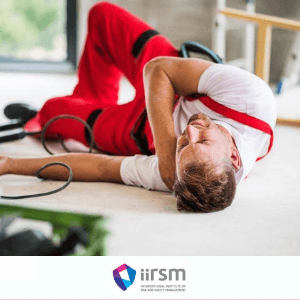Slips, Trips & Falls Awareness
Slips, trips and falls account for almost a third of non fatal injuries at work. It is a widely thought that, with just a few minor changes to working practices, along with better awareness and training, we would see significantly fewer accidents of this type. Legislation relating to these accidents come under The Health and Safety at Work Act 1974 (HSW Act). Two other relevant pieces of legislatons are: The Management of Health and Safety at Work Regulations 1999 and The Workplace (Health, Safety and Welfare) Regulations 1992.
Statistics relating to why people were off work due to accidents share that a third wheel because of back pain or problems with knees, hips and elbows. Another third are off sick because of slips, trips and falls. This is one of the reasons slips, trips and falls get grouped together. Because when combined, they make up a third of the reason why people are off work. It’s convenient. It’s neat, but it doesn’t give an accurate picture.
Employers should manage slip and trip risks as they would any other risks or any other aspects of their business, such as production volumes or product quality. With slips andtrips, a small investment can give an immediate reduction in risk.
Course Categories
The course examines some of the basic facts about slips, trips and falls, and why it’s so important to understand and control these events. Although at first glance, it might seem that slips trips and falls are essentially the same, they are ultimately different and should be assessed individually.
Slip, trip and falls hazards are placed into three distinct categories, which enables managers to better able to identify specific dangers and make more accurate risk assessments. These hazards that fall under the heading “Slips, trips and falls” are covered in separately in the training and give the learner key action points to work with in each area.
Systems and Documentation
Management System and other documentation
You will be given the tools to put an effective management system in place to handle these types of hazards. An efficient management system for slips and trips will help identify problem areas and decide what needs to be done to control the risks. It will also help you act on decisions, check the effectiveness of the steps taken and ensure compliance with legislation. The system has to assess the risk to employees and other people who may be affected by their work, including visitors, suppliers and members of the public. Workers also needs to be involved and committed to reducing risks.
Other Documentation
It’s a good idea to develop an incident documentation form tailored to your business. You should keep a copy of all incident reports in a safe place. Other documents you should file include regular premises inspections, floor care maintenance records, and copies of maintenance agreements with outside suppliers
The HSE have also produced a useful guide which details the uses of these pieces of legislation in relation to the management of slips, trips and falls: Preventing Slips and Trips at Work
| Course Content | Module |
| Serious Facts and the Law | 1 |
| Slip Hazards: Causes and Controls | 2 |
| Trip Hazards: Causes and Controls | 3 |
| Management Issues | 4 |
Course Assessment
Online assessment for this slips, trips and falls training is carried out by a series of multiple choice questions. Candidates must answer 70% of the questions correctly to pass each module. We advise you to complete each module and answer the question before moving on to the next module. This provides a better learning experience because you will need to have knowledge from earlier modules to understand some of the material in the later modules. For those who complete the course successfully, a PDF certificate of the award is sent directly to your inbox. Hard copies of the award are available on request. The course takes 60 minutes of training to complete. This is course content only and does not cover the time it takes to answer questions.



